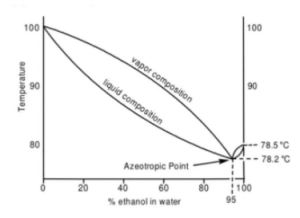Check here: IAS Final Result 2023
Ideal solution:
Ideal solutions are those that adhere to Raoult’s law throughout the whole concentration range.
There are two important qualities of the best solutions.
The mixing enthalpy of the pure components to make the solution, as well as the mixing volume, are both zero, i.e.
It means that no heat is absorbed or released when the components are mixed together. Furthermore, the volume of the solution would be equal to the sum of the volumes of the two components.
Non-ideal solution:
In contrast to ideal solutions, whose volumes are strictly additive and mixing is always complete, the volume of a non-ideal solution is not always the simple sum of the volumes of the component pure liquids, and solubility is not guaranteed across the whole composition range.
Check out the complete UPSC Syllabus
Discover Unacademy UPSC Coaching Centres in the following locations
Characteristics of Non-ideal Solutions
Non-ideal solutions have the following characteristics: • Interactions between solutes and solutes, as well as solvents and solvents, differ from interactions between solutes and solvents.
Heat may have been emitted if the enthalpy of mixing is negative (
); heat may have been detected if the enthalpy of mixing is positive ().
The mixing volume, i.e.
, indicates that the solution will expand or compress in some way.
Also see: UPSC Notes
Limitations of the law
Raoult’s law is particularly important since it explains ideal solutions, which are those in which the gas phase has thermodynamic properties similar to that of a mixture of ideal gases. The main issue is that they are uncommon and difficult to obtain.
Due to the lack of chemical equivalency between different chemical components, many solutions depart from Raoult’s law. As a result, you won’t be able to follow it well.
Deviation from Raoult’s law
A positive deviation indicates that the vapour pressure above the solution is higher than expected. A negative divergence, on the other hand, indicates that the solution’s vapour pressure is lower than expected.
Visit to know more about How to Prepare for UPSC without Coaching
Positive deviation:
If the A-B interactions in solutions are weaker than the A-A and B-B interactions in the two liquids that make up the solution, then A and B kinds of molecules have a higher tendency to escape from the solution than from pure liquids. As a result, according to Raoult’s law, each component of the solution has a partial vapour pressure that is higher than expected. The total vapour pressure will be higher than the vapour pressure that would be expected in a perfect solution with the same composition. Positive departures from Raoult’s law indicate this type of solution behaviour.
for positive deviation.
The following are some examples of solutions with positive deviations:
Ethyl alcohol and cyclohexane
Acetone and carbon disulphide
Negative deviation:
The A-B interactions in such solutions are stronger than the A-A and B-B interactions in the two liquids that make up the solution. Because of the greater A-B interactions, A and B types of molecules have a lower tendency to escape from solutions than pure liquids. As a result, based on Raoult’s law, each component of the solution has a partial vapour pressure lower than expected. As a result, the total vapour pressure is lower than the vapour pressure that would be predicted in a perfect solution.
for negative deviation
The following are some examples of solutions with positive deviations:
chloroform and methyl acetate
acetic acid and pyridine
Difference between positive and negative deviation:
Positive deviation | Negative deviation |
| |
| |
| |
Endothermic dissolution | Exothermic dissolution |
| |
Heating increases solubility | Decreases solubility |
Conclusion:
A solution that follows Raoult’s law is referred to as a “ideal solution.” This law only applies to dilute solutions, yet it is followed by some liquid combinations over a wide concentration range.
As the solute concentration rises, the molecules on the surface induce a drop in vapour pressure. Solvent molecules make up the entire surface of a pure solvent. These are the molecules on the surface of the water that will dissolve in the vapour phase. As the solute concentration rises, fewer solvent molecules on the surface can escape to the vapour phase. Some of the surface patches have been occupied by solute molecules. As a result, the total vapour pressure is lowered.
 Profile
Profile Settings
Settings Refer your friends
Refer your friends Sign out
Sign out














